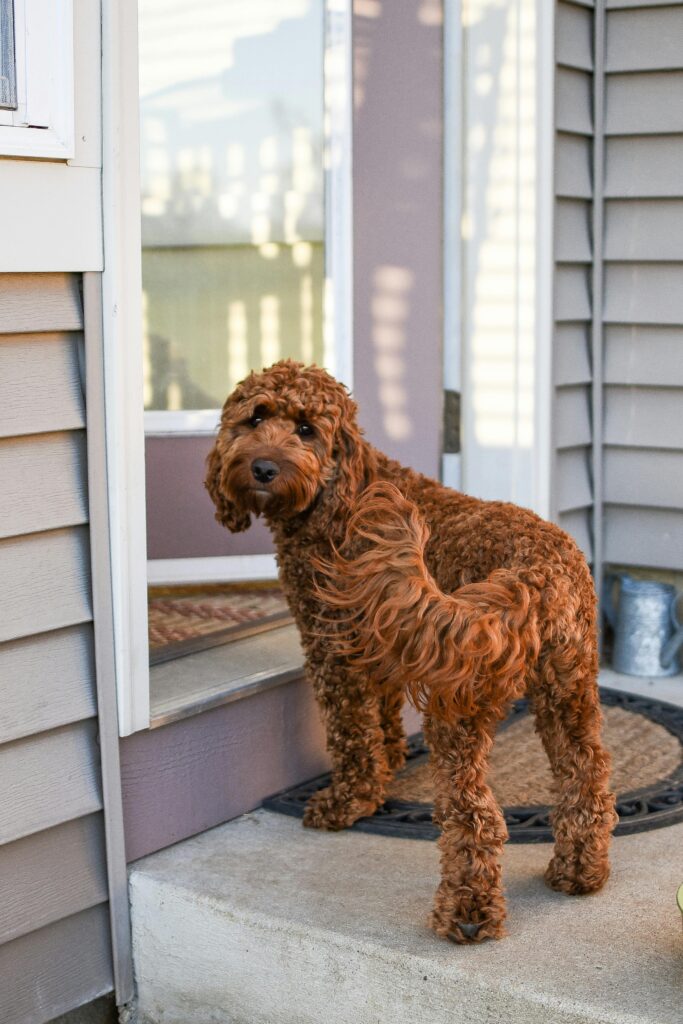Introduction
Goldendoodles vs Labradoodles. As crossbreeds between the beloved Golden Retriever and Poodle, and Labrador Retriever and Poodle, respectively, these Doodles bring a perfect blend of intelligence, affection, and charm to households around the globe. Join us on a journey as we unravel the distinctive traits, temperaments, and quirks that set these delightful Doodles apart.
Goldendoodles vs Labradoodles: Their Differences
While both Goldendoodles and Labradoodles share the endearing qualities of being Poodle Crosses, each breed possesses unique characteristics that set them apart. Let’s delve into the distinctive traits that define Goldendoodles and Labradoodles:
1. Origins and Parentage:
– Goldendoodle: A cross between a Golden Retriever and a Poodle, the Goldendoodle inherits the intelligence and friendliness of the Golden Retriever, coupled with the hypoallergenic coat from the Poodle.
– Labradoodle: Originating from a Labrador Retriever and Poodle mix, the Labradoodle combines the Labrador’s outgoing nature with the Poodle’s intelligence and low-shedding coat.
2. Coat Characteristics:
– Goldendoodle: Known for a variety of coat types including wavy, curly, or straight, Goldendoodles often exhibit a luxurious, non-shedding coat, making them suitable for individuals with allergies.
– Labradoodle: Labradoodles also showcase diverse coat textures, ranging from straight to curly. Like Goldendoodles, they typically have a low-shedding coat.
3. Appearance and Size:
– Goldendoodle: Generally, Goldendoodles exhibit a slightly longer muzzle, and their appearance may vary based on the specific generation (F1, F1B, etc.). They come in three sizes: miniature, medium, and standard.
– Labradoodle: Labradoodles often have a broader head and muzzle, reflecting the Labrador influence. They also come in various sizes: miniature, medium, and standard.
4. Temperament and Personality:
– Goldendoodle: Renowned for their friendly and adaptable nature, Goldendoodles are affectionate, social, and thrive in various family settings. They tend to get along well with children and other pets.
– Labradoodle: Labradoodles are known for their intelligence, sociability, and gentle demeanor. Their friendly disposition makes them excellent family pets, and they often enjoy participating in activities with their human companions.
5. Energy Levels and Exercise Needs:
– Goldendoodle: While energetic and playful, Goldendoodles may have a slightly more laid-back nature compared to Labradoodles. Regular exercise, playtime, and mental stimulation contribute to their well-being.
– Labradoodle: Labradoodles are known for their high energy levels. They often require ample exercise and mental challenges to keep them content. Engaging in activities like fetch, jogging, or agility exercises is beneficial.
6. Common Health Concerns:
– Goldendoodle: Like any breed, Goldendoodles may be prone to certain health issues such as hip dysplasia and progressive retinal atrophy. Responsible breeding practices and regular veterinary check-ups are essential.
– Labradoodle: Labradoodles may face health concerns like hip dysplasia, eye conditions, and certain skin conditions. Regular veterinary care and a well-balanced diet contribute to their overall health.
Understanding these differences allows prospective dog owners to make informed decisions based on their preferences, lifestyle, and the specific qualities they seek in a furry companion. Whether it’s the affectionate charm of the Goldendoodle or the intelligent playfulness of the Labradoodle, both breeds offer unique and lovable qualities to enrich the lives of their human counterparts.
Physical Differences
Goldendoodles And Labradoodles Colors
Goldendoodles vs Labradoodle Cost Comparison
Temperament of Goldendoodles vs Labradoodles
Goldendoodles are celebrated for their affectionate and intelligent nature, combining the traits of their Golden Retriever and Poodle parent breeds. Here’s a closer look at the temperament that makes Goldendoodles cherished companions.
The temperament of a Golden Doodle is a delightful blend of the intelligence and friendliness inherited from both its Golden Retriever and Poodle parentage. Known for their sociable nature, these dogs are often outgoing, affectionate, and eager to please. Golden Doodles are highly adaptable, making them suitable for various living environments, and they tend to get along well with children and other pets. If you want to delve deeper into the fascinating world of Golden Doodle temperament, I encourage you to read our recent blog post titled “Golden Doodle Temperament.”
Labradoodles, a cross between Labrador Retrievers and Poodles, exhibit a delightful temperament that combines intelligence, sociability, and a gentle nature. Here are key aspects of Labradoodle temperament:
1. Intelligent and Trainable:
– Labradoodles are known for their intelligence, often ranking high in trainability. They respond well to positive reinforcement, making them suitable for various activities and training exercises.
2. Friendly and Outgoing:
– With the sociable nature inherited from both parent breeds, Labradoodles are generally outgoing and friendly. They enjoy interacting with people, including children, and are often welcoming to new faces.
3. Gentle Demeanor:
– Labradoodles are recognized for their gentle and patient demeanor, particularly with children. Their tolerant nature makes them suitable family pets, and they often form strong bonds with their human companions.
4. High Energy Levels:
– Labradoodles are known for their high energy levels. They require regular exercise and mental stimulation to keep them content. Engaging in activities like fetch, playtime, and outdoor adventures is essential.
5. Adaptable to Family Life:
– Labradoodles adapt well to family life, enjoying participation in various activities. They are often described as versatile companions, equally comfortable in indoor settings and outdoor adventures.
6. Low to Moderate Shedding:
– Depending on the specific coat type, Labradoodles may exhibit low to moderate shedding. This quality, combined with their hypoallergenic characteristics, can be appealing for families with allergy concerns.
Both Goldendoodles and Labradoodles bring unique qualities to the table, and the choice between them often depends on individual preferences, lifestyle, and the specific temperament characteristics that align with a family’s needs. Whether it’s the warm affection of the Goldendoodle or the intelligent sociability of the Labradoodle, both breeds offer delightful companionship to enhance the lives of their owners.
Energy Levels of Goldendoodles vs Labradoodles: A Comparisom
Goldendoodles typically exhibit a well-balanced energy level that combines playfulness with moments of calmness. Here’s a closer look at their energy dynamics:
1. Playful and Energetic:
– Goldendoodles are known for their playful and lively nature. They enjoy engaging in interactive games, fetch, and outdoor activities that allow them to burn off excess energy.
2. Adaptability to Activity Levels:
– While they have bursts of energy, Goldendoodles are adaptable to varying activity levels. They can match the energy of an active family during playtime but are also content with quieter moments indoors.
3. Exercise Requirements:
– Regular exercise is essential to keep Goldendoodles mentally stimulated and physically fit. Daily walks, play sessions, and opportunities for off-leash activities contribute to their overall well-being.
4. Calm Demeanor Indoors:
– Goldendoodles often exhibit a calm demeanor indoors, making them suitable for apartment living or households with limited outdoor space. They can adapt to a more relaxed environment when their exercise needs are met.
5. Well-Behaved Companions:
– With proper exercise and mental stimulation, Goldendoodles tend to be well-behaved companions. They can transition between active play and moments of relaxation, making them versatile additions to various lifestyles.
Labradoodles are known for their enthusiastic and high energy levels, bringing a playful and lively spirit to their interactions. Here’s a closer look at their energy dynamics:
1. High Energy Levels:
– Labradoodles are typically characterized by high energy levels. They thrive on physical activity and mental stimulation, requiring regular exercise to keep them content.
2. Playful and Engaging:
– Playfulness is a hallmark of the Labradoodle temperament. They enjoy interactive games, play sessions, and outdoor activities that allow them to channel their energy in a positive manner.
3. Exercise Requirements:
– Regular exercise is crucial for Labradoodles to prevent boredom and potential behavioral issues. Activities such as fetch, jogging, or agility exercises help them expend energy and stay mentally stimulated.
4. Adaptable to Active Lifestyles:
– Labradoodles are well-suited for families with active lifestyles. They thrive in environments where they can participate in various activities, and their high energy levels make them excellent companions for outdoor adventures.
5. Training and Socialization:
– While their energy levels are high, Labradoodles respond well to training and socialization. Positive reinforcement methods can be effective in channeling their enthusiasm into well-behaved behavior.
Understanding the energy levels of both Goldendoodles and Labradoodles allows prospective owners to make informed decisions based on their lifestyle, preferences, and the level of activity they can provide for their furry companions. Whether seeking a versatile and adaptable energy balance or a more energetically dynamic companion, both breeds offer unique qualities to enrich the lives of their human counterparts.
Lifespan of Goldendoodles And Labradoodles
The lifespan of a Goldendoodle, like many dog breeds, can vary based on several factors, including genetics, size, overall health, and lifestyle. On average, Goldendoodles typically live between 10 to 15 years. Responsible breeding practices, regular veterinary care, a balanced diet, and a healthy lifestyle contribute to their longevity. If you want to find out more about the Golden Doodle lifespan, check out our recent blog post: Golden Doodle Lifespan
Labradoodles, like Goldendoodles, have a lifespan influenced by various factors. On average, Labradoodles typically live between 10 to 15 years. Similar to Goldendoodles, responsible breeding, attentive healthcare, proper nutrition, and an enriching lifestyle contribute to their well-being and longevity.
Factors Influencing Labradoodle Lifespan:
1. Genetics: The genetic makeup of a Labradoodle plays a crucial role in determining its lifespan. Reputable breeders focus on breeding for health and longevity.
2. Size: As with Goldendoodles, the size of a Labradoodle can impact its lifespan. Smaller Labradoodles may generally have a longer life expectancy than larger ones.
3. Healthcare: Regular veterinary care, vaccinations, preventive measures, and prompt attention to any health concerns contribute to a Labradoodle’s overall health and longevity.
4. Nutrition: A well-balanced and appropriate diet tailored to the Labradoodle’s size, age, and health requirements is essential for a healthy and long life.
5. Lifestyle: An active and engaging lifestyle, with regular exercise, mental stimulation, and social interaction, promotes the well-being and happiness of Labradoodles.
It’s important for dog owners to provide a loving and nurturing environment, attend to their pet’s healthcare needs, and ensure a lifestyle that promotes both physical and mental well-being. While lifespans can vary, the joy and companionship shared with Goldendoodles and Labradoodles create cherished moments that last a lifetime.

Grooming Goldendoodles
Grooming Goldendoodles involves caring for their distinctive coats, which can range from wavy to curly. Regular grooming not only maintains their appearance but also contributes to their overall health and comfort. Here’s a guide to Goldendoodle grooming:
1. Brushing:
– Goldendoodles have non-shedding coats that require regular brushing to prevent matting and tangling. The frequency of brushing depends on the coat type:
– Curly Coat: Brush every 6-8 weeks
– Wavy Coat: Brush every 4-6 weeks
– Straight Coat: Brush every 4-8 weeks
– Use a slicker brush or a comb to gently remove loose hair and prevent knots.
2. Bathing:
– Bathe your Goldendoodle as needed, typically every 6-8 weeks or when they get dirty. Use a mild dog shampoo to avoid skin irritation.
– Ensure thorough rinsing to remove all soap residue, as leftover shampoo can cause skin issues.
3. Ear Cleaning:
– Goldendoodles are prone to ear infections due to their floppy ears. Regularly clean their ears with a veterinarian-approved ear cleaning solution to prevent wax buildup and infections.
4. Nail Trimming:
– Trim your Goldendoodle’s nails every 4-6 weeks or as needed. Use a dog nail clipper or grinder, being cautious not to cut into the quick.
5. Professional Grooming:
– Consider professional grooming every 8-12 weeks, depending on your Goldendoodle’s coat type and your grooming preferences. Professional groomers can provide more intricate grooming services.
6. Face and Paw Maintenance:
– Keep the hair around their eyes and muzzle trimmed to prevent irritation and promote clear vision.
– Regularly check and trim the hair between their paw pads to prevent matting and discomfort.

Grooming Labradoodles
Labradoodles boast a variety of coat types, including curly, wavy, and straight. Grooming these intelligent and sociable dogs is essential to maintain their coat health and overall well-being. Here’s a guide to Labradoodle grooming:
1. Brushing:
– Brushing frequency depends on the Labradoodle’s coat type:
– Curly Coat: Brush every 4-6 weeks
– Wavy Coat: Brush every 4-6 weeks
– Straight Coat: Brush every 6-12 weeks
– Use a slicker brush or comb to prevent matting and remove loose hair.
2. Bathing:
– Bathe your Labradoodle every 6-8 weeks or when necessary. Use a mild dog shampoo to keep their coat clean and healthy.
– Regular baths help manage allergens and keep their coat in good condition.
3. Ear Cleaning:
– Labradoodles, especially those with floppy ears, are prone to ear infections. Clean their ears regularly with a veterinarian-approved solution to prevent issues.
4. Nail Trimming:
– Trim your Labradoodle’s nails every 4-6 weeks. Use a dog nail clipper or grinder, being cautious not to cut into the quick.
5. Professional Grooming:
– Schedule professional grooming every 6-12 weeks, depending on your Labradoodle’s coat type and your preferences. Professional groomers can provide specialized services.
6. Face and Paw Maintenance:
– Trim the hair around their eyes and muzzle to prevent irritation and ensure clear vision.
– Regularly check and trim the hair between their paw pads to prevent matting and discomfort.
General Tips for Doodle Grooming
– Start Early: Introduce grooming routines early in your Doodle’s life to create a positive association.
– Positive Reinforcement: Use treats and praise to reward good behavior during grooming sessions.
– Regular Checkups: Regularly check ears, eyes, teeth, and overall coat condition for signs of health issues.
– Consult Professionals: Seek advice from professional groomers or veterinarians for specific grooming needs based on your Doodle’s coat type.
Grooming is not only a practical necessity for Goldendoodles and Labradoodles but also a bonding experience that fosters trust and care between you and your furry friend.
Training Goldendoodles
Goldendoodles, known for their intelligence and eagerness to please, are generally receptive to training. Consistent, positive reinforcement methods work well with these affectionate dogs. Here’s a guide to training Goldendoodles:
1. Early Socialization:
– Begin socializing your Goldendoodle puppy early to expose them to various people, environments, and situations.
– Socialization helps prevent fearfulness and encourages a well-adjusted and confident adult dog.
2. Basic Commands:
– Teach essential commands like sit, stay, come, and down using positive reinforcement techniques.
– Use treats, praise, and rewards to reinforce good behavior and responses to commands.
3. Obedience Training:
– Enroll your Goldendoodle in obedience classes to build a strong foundation for good behavior.
– Obedience training fosters communication between you and your dog, establishing a positive relationship.
4. Positive Reinforcement:
– Goldendoodles respond well to positive reinforcement, including treats, verbal praise, and affection.
– Reinforce good behavior immediately to create a strong association between the action and the reward.
5. Consistency is Key:
– Be consistent in your commands, rewards, and rules. Inconsistency can confuse your Goldendoodle and impede their learning.
6. Patience and Understanding:
– Practice patience and understanding during training sessions. Goldendoodles aim to please but may take time to master commands.
7. Avoid Harsh Methods:
– Avoid harsh training methods or punishment, as Goldendoodles respond better to positive reinforcement and gentle guidance.
Training Labradoodles
Labradoodles, like Goldendoodles, are intelligent and sociable, making them receptive to training. Positive reinforcement methods and a focus on building a strong bond contribute to successful training. Here’s a guide to training Labradoodles:
1. Early Socialization:
– Start socializing your Labradoodle puppy early to expose them to various people, animals, and environments.
– Early socialization promotes a well-adjusted and friendly adult dog.
2. Basic Commands:
– Teach fundamental commands such as sit, stay, come, and down using positive reinforcement.
– Use treats, praise, and rewards to reinforce positive behavior and responses to commands.
3. Obedience Training:
– Enroll your Labradoodle in obedience classes to establish a foundation for good behavior.
– Obedience training enhances communication between you and your dog, fostering a positive and cooperative relationship.
4. Positive Reinforcement:
– Labradoodles respond well to positive reinforcement, including treats and verbal praise.
– Reinforce good behavior promptly to strengthen the connection between the action and the reward.
5. Consistency is Crucial:
– Maintain consistency in your commands, rewards, and training methods. Labradoodles thrive on routine and clear expectations.
6. Patience and Encouragement:
– Practice patience and provide encouragement during training sessions. Labradoodles are eager to learn but may require time to grasp commands.
7. Avoid Negative Methods:
– Steer clear of negative or harsh training methods. Labradoodles respond best to positive reinforcement and gentle guidance.
Training Tips for Doodles:
– Varied Environments: Train in different settings to generalize commands across various situations.
– Interactive Toys: Use interactive toys and games for mental stimulation, keeping training sessions engaging.
– Regular Exercise: Ensure your Doodle receives adequate physical exercise to maintain focus during training.
– Professional Training Classes: Consider professional training classes for structured learning and guidance.
Training Goldendoodles and Labradoodles is a rewarding experience that strengthens the bond between you and your furry companion. Positive reinforcement, patience, and a consistent approach contribute to successful training outcomes.
Goldendoodles and Labradoodles: Shared Traits and Similarities
Goldendoodles and Labradoodles, both cherished members of the Doodle family, share several similarities that contribute to their popularity as family pets. These common traits highlight the appeal of these lovable and intelligent hybrid breeds:
1. Friendly and Social:
– Both Goldendoodles and Labradoodles are renowned for their friendly and sociable nature. They tend to get along well with people of all ages, making them excellent family companions.
2. Intelligence:
– Intelligence is a shared characteristic, as both breeds inherit the smart and trainable qualities of their parent breeds—the Golden Retriever and the Labrador Retriever.
3. Affectionate:
– Goldendoodles and Labradoodles are known for their affectionate nature. They thrive on human interaction, forming strong bonds with their families and displaying loyalty and love.
4. Versatile Companions:
– Whether you lead an active lifestyle or prefer a more laid-back routine, both breeds adapt well to various living environments. They are versatile companions suitable for families, singles, and seniors alike.
5. Low Shedding Coats:
– One of the key attractions of Doodle breeds is their low shedding coats. Both Goldendoodles and Labradoodles often have hypoallergenic qualities, making them suitable for individuals with allergies.
6. Eager to Please:
– Both breeds share a desire to please their owners. This eagerness to please contributes to their trainability and makes them responsive to positive reinforcement methods.
7. Good with Children:
– Goldendoodles and Labradoodles are generally good with children, displaying patience and a gentle demeanor. Their playful nature makes them ideal playmates for kids.
8. Activity Levels:
– While activity levels can vary within each breed, both Goldendoodles and Labradoodles typically require regular exercise to keep them physically and mentally stimulated.
9. Therapy and Assistance Work:
– Many Doodles, including Goldendoodles and Labradoodles, excel in therapy and assistance work. Their friendly and calm disposition makes them well-suited for providing comfort and support in various roles.
10. Adaptable Grooming Needs:
– Both breeds have coats that require regular grooming, but the specific grooming needs can vary based on the individual dog’s coat type. Regular brushing, occasional bathing, and attention to ears and nails are common grooming practices.
Understanding these shared traits helps prospective owners appreciate the qualities that make Goldendoodles and Labradoodles beloved additions to countless households. Whether you’re drawn to the Golden Retriever lineage or the Labrador Retriever heritage, both Doodle breeds offer a delightful blend of charm, intelligence, and affection.
Goldendoodles and Labradoodles: Similarities
As members of the popular Doodle family, Goldendoodles and Labradoodles share a multitude of endearing characteristics that make them beloved pets. Here’s a glimpse into the shared traits that contribute to the charm of these delightful hybrid breeds:
1. Affectionate Nature:
– Both Goldendoodles and Labradoodles are renowned for their affectionate and loving demeanor. They thrive on human companionship, forming strong bonds with their families.
2. Intelligence and Trainability:
– Inheriting the intelligence of their parent breeds, Golden Retrievers and Labrador Retrievers, both Doodle variations are highly trainable. They respond well to positive reinforcement and enjoy mental stimulation.
3. Social Butterflies:
– Whether with family members, friends, or strangers, Goldendoodles and Labradoodles are social butterflies. Their friendly disposition makes them excellent companions for various social settings.
4. Adaptability:
– These breeds exhibit adaptability to different living environments. Whether in a bustling family home or a quieter setting, both Goldendoodles and Labradoodles can adjust and thrive.
5. Low Shedding Coats:
– One of the standout features of Doodle breeds is their low shedding coats. Both Goldendoodles and Labradoodles often possess hypoallergenic qualities, making them suitable for individuals with allergies.
6. Playful and Energetic:
– Sharing playful and energetic traits, these Doodles love engaging in activities with their families. Playtime, walks, and interactive games contribute to their overall well-being.
7. Good with Children:
– Known for their gentle and patient demeanor, Goldendoodles and Labradoodles typically get along well with children. Their playful nature makes them wonderful companions for young family members.
8. Therapeutic Capabilities:
– Many Doodles, including Goldendoodles and Labradoodles, excel in therapy roles. Their calm and comforting presence makes them well-suited for providing emotional support in various therapeutic settings.
9. Versatile Sizes:
– Both breeds offer a range of sizes, from miniature to standard, allowing prospective owners to choose a size that fits their living space and preferences.
10. Grooming Needs:
– While specific grooming requirements may vary based on coat type, both breeds generally benefit from regular brushing, occasional bathing, and attention to ears and nails.
Understanding the shared traits of Goldendoodles and Labradoodles allows prospective owners to appreciate the versatility, intelligence, and affection these Doodle companions bring into homes. Whether seeking a fluffy friend for a lively household or a gentle therapy companion, both breeds showcase the best of Doodle charm.




